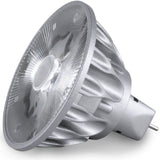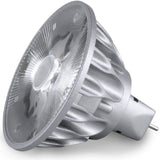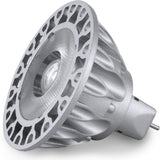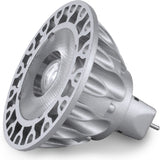Why is Replacing Halogen 12V MR16 with LED A Challenge? Updated Late 2016
Posted by Dave on for ProLampSales

Over two years ago, when we wrote this original post, there was general angst from lighting designers, contractors and owners about the usefulness of LED MR16 bulbs as viable replacements for halogen MR16 in commercial display lighting applications.
At the time, we cited a USDOE report from 2014 that showed "very few of the LED MR16 lamps listed in the LED Lighting Facts program are comparable replacements for the popular 12V 50W halogen MR16". Only one lamp tested provided comparable center beam candlepower. Most manufacturers did not even bother to provide that specification. In addition the number of LED MR16 products on the market was declining significantly, an indication of the difficulties manufacturers faced with this category of LED lamp.
In November 2015 , USDOE published a follow-up report (see below) on the status of LED MR16s. That report showed that LED MR16 lamps intended to replace 20W and 35W halogen MR16s performed reasonably well, but LED replacements for the popular 50W category of halogen under-performed compared to halogen.
It is now another year later, a good time to revisit the status of LED MR16 lamps.
The Challenge: Halogen MR16
Halogen MR16s, particularly with the popular 50W lamps, provide retail and display lighting applications with a 12 volt, point source, small 2" diameter aperture lamp, excellent color temperature and color rendering characteristics, beam angle options as well as light control accessories such as special lenses.
The halogen MR16 has been a workhorse lamp for display and accent lighting applications, with millions of these lamps installed today.
The halogen MR16 package has been the most challenging of any category of lamps for LED manufacturers to replicate. While color and beam characteristics can usually closely replicate halogen, the low lumen density of LED required work-around strategies that ultimately have prevented LED MR16 lamps from replicating the center beam candlepower and quality of directional lighting, particularly in the popular 50W halogen MR16 format.
Early Generation LED MR16: Low Lumen Density
While an LED can come reasonably close to a point source, like halogen, it has low lumen density. To overcome this issue, manufacturers have historically ganged multiple LEDs to create a directional lamp that achieves, or attempts to achieve, similar lumen density as halogen. Unfortunately these multiple LED sources, while rarely producing the lumen density required, also create artifacts such as color shadows that compromise the quality of the illumination so important for many display lighting applications.
Latest Generation LED MR16: True Point Source
Recently, breakthroughs using GaN on GaN technology have allowed a single point source LED MR16 to be built. This important technology advance means LED MR16 lamps based on GaN on GaN can have lumen packages that replicate 20W and 35W halogen and come increasingly closer to the 50W halogen MR16.
One manufacturer in particular, SORAA, has developed a strong line of GaN on GaN directional lamps, including MR16s that for the first time provide point source illumination that comes very close to replicating halogen.
A few guidelines to consider when choosing these latest generation LED MR16 lamps:
Center Beam Candle Power: LED MR16 lamps generally cannot meet the halogen values especially at narrower beam angles, but they are much closer than previous generations of LED MR16 lamps particularly at 35W and 50W equivalent lamps.
Color Rendering: 80 CRI LED MR16 lamps, offered in both 2700K and 3000K color temperatures, provide higher efficacy (lumens/watt) than 90 CRI LED lamps. When color rendering is not critical for the application, choose 80 CRI for higher output at the same wattage.
Optics: These latest generation LED MR16 lamps are free of spill light (more so than halogen), allowing for easier shielding when necessary.
Shadowing: A truer point source reduces the transition shadow created by the earlier generation LED MR16 (multi-source) lamps.
Whitening Effect: Some of the latest generation LED MR16 lamps use "violet pumping" instead of "blue pumping" that can produce a "whiter than white" effect.
The conclusion: specification grade LED MR16s using GaN on GaN technology, like those from manufacturer SORAA, will be a very good to excellent halogen replacement at beam angles in the range of 25° to 60°. For spot distribution, 10° to 15°, it’s important to do side-by-side tests to visually determine if the desired illumination intensity is achieved.
Read the LED MR16 2015 USDOE Lighting Facts report.
Featured Products (View All)
- 0 Comments
- Posted in Halogen, LED
0 Comments




